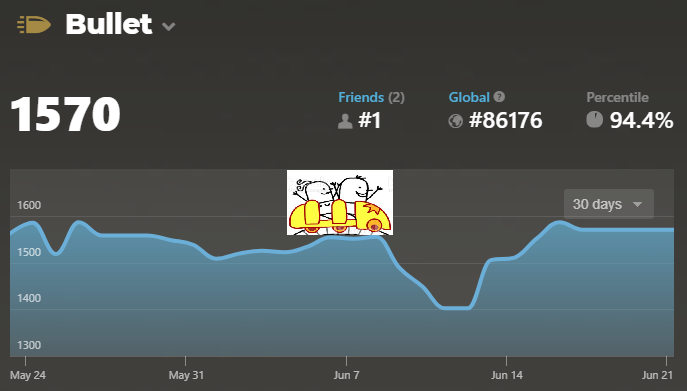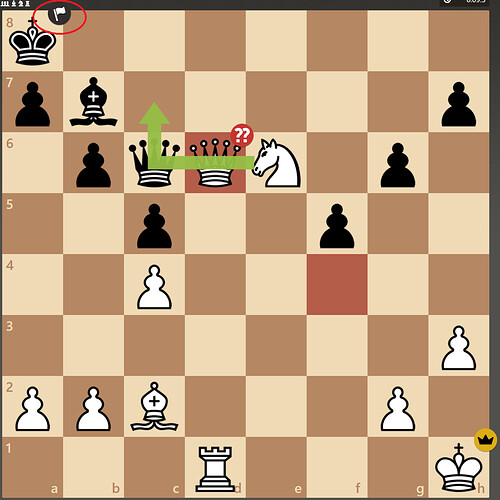Must be the same Spanish guy I played on a travel set in a backstreet bar in Malaga once, who insisted each side has two moves when it’s their turn lol. As his face was covered in scars and he looked as rough as fuck I wasnt about to argue with him.
God I really hate the way chess.com display their premoves. I have lost about 20 games for the crime of forgetting that the piece isn’t actually on the square that it is fucking displayed on. (lichess show the premove squares highlighted but don’t actually move the piece).
Yes, I find my chess.com rating fluctuates about 200 points from peak to trough. Variance is much higher online I think…people play drunk or get distracted, or maybe play on each other’s accounts.
Not sure what you guys are talking about.

I do think this is a thing, chess can induce tilt on a weird way where you impulsively make attractive moves and overlook threats and/or better moves.
Also I think day/time matters quite a lot in the same way it did with online poker.
I’ve been playing a bunch of 1-2 day/move games on chess.com
I’m like 3-5 with two wins coming because my opponent timed out, and its not like I was winning either game.
Rating is 1475 which strikes me about 250 points too high but it won’t go any lower because of these unearned wins.
My biggest issue is getting to the end of standard openings and just not having any clue what to do next. There’s no purpose to any of my moves and I’m merely making moves that don’t leave pieces hanging.
Study the endings more. That will give you a much better idea of which ones are winning, drawing and losing, which will give you a better idea of things to consider in the middle game eg good/bad bishops, pawn majorities, king and minor piece activity etc.
You’re probably missing a lot of opportunities to liquidate to a good ending or from a worse position into a drawn ending.
Sure, but what does the resulting position look like?
Pawn weaknesses
Piece development
King safety
etc
Ok, you’re looking first for tactics which is good, but you also need to keep a strategic view in your mind once you see what your strengths/weaknesses are (these are often fluid of course) and what are those of your opponent.
Aim to induce weaknesses in his position - not only pawns but restricting the mobility of his pieces etc.
Many times you’re not going to win a piece but you’ll win in the ending. Sometimes the threat of entering a clearly won ending makes your opponent sac material (another way of winning a pawn/piece).
“The threat is worse than the execution”.
Yes, the parallel with NL is where people ask “What do I do next?” and the answer is “Play poker” which is unhelpful but often true lol.
Chess is a game of exchanging strengths and weaknesses with your opponent.
Once you’ve got your pieces developed, castled, rooks connected, start looking at his position and any difficulties he’s facing, and how you can improve your own pieces.
Play some master games that are annotated.
Play through the chess dot com analyser and see if you can find where you could have improved.
Play through all of Fischer’s excellent 60 most memorable games.
Edit: gaining the bishop pair after completing development is good in most cases (where the pawns aren’t irrevocably locked) even if it means two knight moves in a non “racey”* position.
*meaning a position where there’s a clear race to get developed with the race winner getting a decent edge, implying that tempi are critical
If you don’t care about your rating, this is where you can make chess super fun by sacrificing a piece to blow open the board in front of the opposing king, then just keep throwing punches by checking the opponent, threatening the queen, etc.
You will lose a lot of games but the wins are glorious!
Heh, I told him the opposite, that you should attack the hell out of the king regardless of anything, until you learn when it’s a good idea and when it’s not. I wasn’t joking upthread about Vukovic’s Art Of Attack. Your thing is a good second thing though.
Woke up this morning thinking again about this.
Why didn’t I just tell snoreo that
includes concrete well-annotated examples of attacking the king, attacking on the Q’side, bishop pairs, good knight vs bad bishop, winning material in the middle game, liquidating into good endings?
I got the idea that snoreo’s trying things like Nb5 intending a fork on c7 but getting met with Na6 and c6; or a Bb5 pin to win a pawn that’s met with Bd7, but I don’t know.
Some actual examples would be interesting.
@anon46587892 I’ve got a superabundance of time on my hands - PM me?
Coincidentally I’m going through this atm:
https://www.chess.com/lessons/every-sacrifice-to-destroy-your-opponent-attacking-the-castled-king
Finished the classic B sac on h7 that I see often enough as an e4 player.
g7 should be interesting.
Edit: ah ok Keti - so just one specific example of a super GM brilliancy lol
Ok, now onto f7.
Edit: Oh ok, we just need to play like a famous Fischer brilliancy. No problem.
Which standard openings do you play? Some are more prone to this than others.
The two things I’d recommend thinking if you don’t know what to do are, first, “what does my opponent want” and trying to find a way to prevent that and second, “which of my pieces is unhappy” and coming up with a plan to rectify that. That plan may involve moves other than moving that piece.
My two most common are the Italian (which ends up super congested usually) and the Danish gambit which I’m not nearly good enough to experiment with. I defend with either kings pawn or Sicilian
One suggestion is dont play the Sicilian as a beginner or even an intermediate. Its a great opening for advanced players but my experience is that lesser players will step on a landmine with the Sicilian as often as they execute it well, and I include myself in that group.


